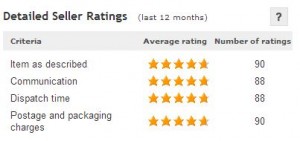From 20th February 2016 eBay will be updating their seller performance standards. This may or may not be a good thing, but it certainly leads you to wonder why they have decided to do it now. According to industry insiders, eBay had a terrible August, and they want to take steps to improve their performance, so they have announced some pretty big changes to help improve matters.
eBay tell us that they’re updating seller performance standards in order to recognise when sellers “deliver a great buyer experience”. They intend to do this by relying on ‘objective’ data instead of ‘subjective’ buyer input – meaning the ratings that buyers leave for sellers which must be a good thing because we all know what a complete nightmare feedback can be!
eBay claim that everything is changing thanks to feedback that they have received from sellers. At this time, the plan is to:
1. Significantly reduce the number of measures that count towards a defect rate
2. Introduce a new ‘on-time delivery metric’ to reflect dispatch and delivery performance.
3. From 1 May 2016, they will extend the required returns period for eBay Top-rated sellers from 14 days to 30 days for most listings.
4. Make delivery and returns improvements – eBay are merging the current returns request procedure and their managed returns process and making it one simple, single returns process.
5. They will expand product identifiers to further categories.
Seller performance standard will be evaluated through the new defect criteria, meaning that from 20 February 2016, buyer feedback, detailed seller ratings (DSRs), returns requests that were successfully resolved with the buyer and item not received requests that were successfully resolved will no longer count towards your defect rate.
The defect rate will instead be based on seller-cancelled transactions and cases that were closed without seller resolution.
The changes for non-top-rated sellers aren’t too bad – you can still have 40% as many defects as before, however if you’re a top-rated seller – especially those among us who use eBay for the core of our business – it’s going to be harder as the maximum allowed defect rate has been cut to a quarter of what it was previously.
The new on-time delivery metricOver the past few years eBay has become obsessed with a speedy delivery service. We’ve seen how businesses have been penalised for not offering free packing and postage, meaning that SME’s who can least afford it have to absorb the costs of P & P. We’ve also seen Amazon offer a two-hour express delivery service in some cases, and Argos has rolled out its new same day delivery service. eBay has to compete!
Now eBay are launching their ‘on-time delivery metric’ which will measure delivery performance based on how quickly you package and post your items. You will be required to post items within your stated dispatch time and upload valid tracking information, or have your buyer confirm the item was delivered on time if you don’t want your on-time delivery rate affected.
If you claim that you dispatch within 24 hours and you estimate delivery within two days (giving you a total of three days from the moment of order) then as long as you do go ahead and post within 24 hours, it won’t be considered a late delivery, even if your courier takes three days to deliver, and not two. Conversely, if you take two days to get the parcel dispatched and the delivery company deliver in one day, you also won’t have a late delivery on your hands.
Commence and their panel of experts have writen an article about how, you will be penalized for a late delivery if you don’t upload tracking information AND your buyer confirms that the item arrived after the estimated delivery date, OR your tracking system shows that the item was posted after you estimated your dispatch time and also notes the item arrived after the estimated delivery date.
eBay note that “If on-time delivery is the only performance metric you don’t meet, your seller level will remain Above standard. However, we may restrict your delivery options, including the dispatch times you can offer on your listings. We’ll be in touch to let you know if this affects you.”
They also state that “Although you don’t have to provide tracking information, we recommend doing so in order to have more control over your performance,” which is odd given that they’re suggesting they may penalise you if you don’t use tracking information.The truth is of course, that eBay don’t do anything that doesn’t make themselves money. They’re a business not a charity. They have partnered with a number of carriers and these will be the ones favoured by eBay. They may not be the cheapest and therefore may not be attractive to SME’s but as eBay acknowledge, “when you add tracking information from one of these carriers, we’ll measure delivery performance based on your dispatch and delivery times.” So if you want to maintain a high seller rating on eBay – you have to keep feathering the eBay nest. Added to this, not all couriers are integrated, so there’s room for improvement there.
The potentials drawback of this system include that when you choose not to provide tracking information, the buyer has to confirm that delivery was made on time when they leave their Feedback. Plus, if there are issues with the tracking information being recorded correctly, how do you – or can you – contact eBay and sort it out? What proof will you offer them? Which SME even has time to do that?
And of course, delivery method of choice for most people in the UK, rightly or wrongly, is good old Royal Mail. When you post an item via Royal Mail 1st or 2nd Class, it isn’t automatically recorded, you have to pay extra. In addition to that, and worthy of a giggle I think, is that Royal Mail themselves set a minimum service standard of 93% for First Class post. This means that by their own admission 7% of their first class post will not arrive in the stated ‘one day’ window. That comfortably exceeds eBay’s own maximum allowable rate for Top-rated seller status and there’s not a thing you as the seller can do about it.
30 Day Returns
From 1 May 2016, all sellers will need to offer 30-day returns with money back if they want to qualify for the eBay Premium Service discount and badge. eBay say that this will help them to stay competitive as a marketplace – and build buyer confidence while driving sales. eBay note that ‘By offering a 30-day returns window, you’re helping us to stay in line with wider industry standards’. But what are these wider industry standards? 30 days is surely excessive for many items. You can imagine how many times you can wear a pair of socks in 30 days and return them for a new pair when you get a potato in the toe. I joke, but the potential for abuse is available.
Can’t win, won’t win
While the removal of negative or neutral Feedback at first glance is a wonderful thing, don’t be fooled. eBay will still allow neutral and negative Feedback – and it will still appear on your Feedback profile page, it just won’t affect your detailed seller ratings anymore. Sadly, then, it still means people can libel you as often as they like.
The unified returns process
eBay are introducing a basic customisation and automation feature for all sellers which you can see by looking in My eBay > My Account > Site Preferences > Return Preferences. This will allow you to
• Automatically send a refund for items of a certain price and for certain return reasons – especially useful if you know that sorting out a replacement or getting the item back is not worthwhile for you.
• Approve returns automatically for items under a certain price or for certain return reasons. eBay then issues the buyer with a return label that they can use to send the item to you, and you manually refund them when the item is received by you.
You’ll have heard of Amazon Prime? Well eBay Plus is eBay’s answer to this. It provides free, fast shipping and returns to buyers, and eBay are also offering some benefits to sellers who opt in, including a 15% discount on final value fees, better placement in search results, free return labels, and the ability to purchase discounted eBay branded packaging materials. It has yet to roll out in the UK, but worth looking out for.
Final thought
Expert advice suggests that market conditions are uncertain, and eBay’s performance is currently a tad shaky. SME’s should diversify and sell on more than one platforms – don’t keep your eggs in one basket!
Over to you
What are your thoughts? Will the changes make a difference to you and your selling experience on eBay? Let us know below or join us on Facebook for some discussion.
 Wholesale
Wholesale 





Comments are closed.